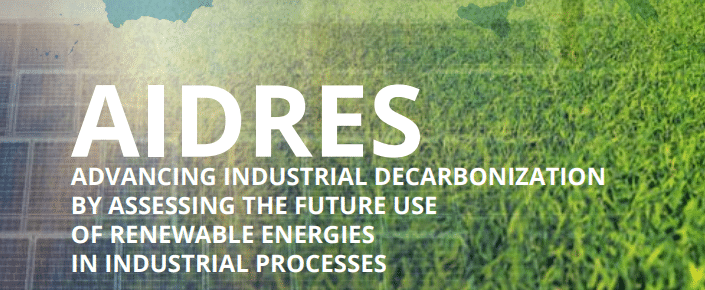AIDRES – Advancing Industrial Decarbonisation by Assessing the Future Use of Renewable Energies in Industrial Processes

The objective of the AIDRES database, sponsored by the EU Commission DG Energy, is to support the EU-27’s long-term goal of achieving a fully integrated industrial strategy. The database is a valuable resource for regional, national and EU policymakers, industries and researchers.
Indeed, it provides insights into energy effectiveness, efficiency, and cost of potential innovation pathways to achieve carbon neutrality in key sectors such as steel, chemicals, cement, glass, fertiliser, and refineries (fuel manufacturing) by 2050. The database considers the geographical distribution of annual production for these sectors at the EU-NUTS3 regional level.
The EU's Drive for Net-Zero Emissions
The IPCC special report on limiting global warming to 1.5℃ has underscored the urgency of efforts to stay below the 2℃ threshold, in line with the ambitions of the Paris Agreement. The European Union (EU) is leading the way with its long-term climate strategy, which aims to achieve carbon neutrality by 2050.
This objective underpins the European Green Deal, a comprehensive initiative designed to transform the EU into a modern, resource-efficient and competitive economy, aiming for net-zero greenhouse gas emissions by 2050. The ‘Fit-for-55′ package, introduced by the European Commission, outlines directives and measures geared toward a 55% reduction in greenhouse gas emissions by 2030, a crucial milestone on the path to net zero by 2050.
AIDRES: Decoding the Path to Carbon Neutrality
EU projections indicate that achieving carbon neutrality relies on measures such as energy efficiency, direct and indirect electrification, production of zero-carbon energy carriers, and carbon capture and use/storage in energy-intensive industries. The goal is to reduce emissions by 90-95% by 2050, while fostering a resource-efficient circular economy. The central question of what the future demand of energy intensive industries in the EU could look like, was formalised in the AIDRES Project and delivered to the EU Commission’s DG Energy.
The AIDRES study takes centre stage in this endeavor, focusing on the steel, chemical, cement, glass, fertiliser, and refinery (fuel manufacturing) sectors across the EU. The study examines the effectiveness, efficiency, and cost of various decarbonisation pathways by 2030 and 2050. The study has developed a comprehensive database, accessible to the public, serving as a critical resource for the Energy and Industry Geography Lab (EIGL) of the Joint Research Centre (JRC) and a set of reports which are available on the Publications Office of the European Union.
AIDRES leverages the latest technologies using OSMOSE to model and categorise decarbonisation options such as process integration, electrification, hydrogen production and carbon capture. Overcoming challenges in data collection, the project collaborates with private industries and sector federations, employing the blueprinting strategy to construct industrially representative process models while safeguarding confidential information. Furthermore, close collaboration with industrial sector federations and selected companies aided the relevance and accuracy of the production process models.
AIDRES Database and EU Mix Use Case
The database includes eight scenarios for each production route, allowing users to explore different parameters like operational costs and CO2 emissions. The study also maps the correlation between industrial sector demands and future renewable energy locations within the EU, using geographical information systems (GIS) for a comprehensive understanding of industrial plant location at NUTS3 level.
By combining EU reference scenarios and industrial sector federations roadmaps, we built the AIDRES EU Mix use case. The results reveal the substantial changes required for the six industries to meet CO2 reduction targets by 2030 and 2050. The AIDRES EU Mix use case demonstrates a reduction in energy and feedstock input, particularly in the refinery sector, due to electrification of transportation. The transition to low-carbon alternatives, such as biomass and green hydrogen, is evident across industries, underlining the pivotal role of these technologies in achieving decarbonisation. The approach of building CO2 emission target-specific use cases, acknowledges the uncertainty surrounding future production routes and provides flexibility for end users to construct customised scenarios.
Harmony in Industry
AIDRES goes beyond individual production routes and synthetic production routes use cases by investigating aspects of symbiosis with a focus on reducing energy and raw material use, following the four “R’s” strategy (reduce, reuse, recycle, recover). The potential of infrastructure mutualisation and resource exchange in five large existing EU industrial clusters is investigated, using the readily available production routes and uses cases from the AIDRES database.
In this framework, the AIDRES report ‘Methodology on industrial symbiosis: supporting the energy transition at industrial clusters’ is available for download below. Focused on industrial symbiosis methodology, the report supports the energy transition in industrial clusters.
Empowering Sustainable Futures
In conclusion, the AIDRES study created a unique database mapping the energy requirements, CO2emissions, and expenses of six key energy-intensive industries. This resource empowers energy system modellers, policymakers, industries, and anyone interested in industrial decarbonisation to formulate scenarios and pathways aligned with the EU’s net-zero emissions vision or their own targets.
Role of EnergyVille/VITO
Energyville/VITO spearheaded this study by coordinating collaboration between the project’s diverse work packages, offering technical expertise and overseeing engagement with the EU Commission’s DG Energy and external industrial stakeholders.
Want to know more?
Curious to learn more about this fascinating project? Below, you can explore the AIDRES final report titled ‘Assessment and geo-mapping of renewable energy demand for technological paths towards carbon neutrality of EU energy-intensive industries’. In addition, you will find a downloadable infographic offering a visual overview of the AIDRES project.
Feel free to download and explore both the AIDRES final report and the infographic for a comprehensive outline of the project details.
Should you have any questions or need further information, our expert Joris Valee is ready to assist you. Do not hesitate to contact him for additional questions or clarifications; he will be happy to guide you through the ins and outs of the project.






